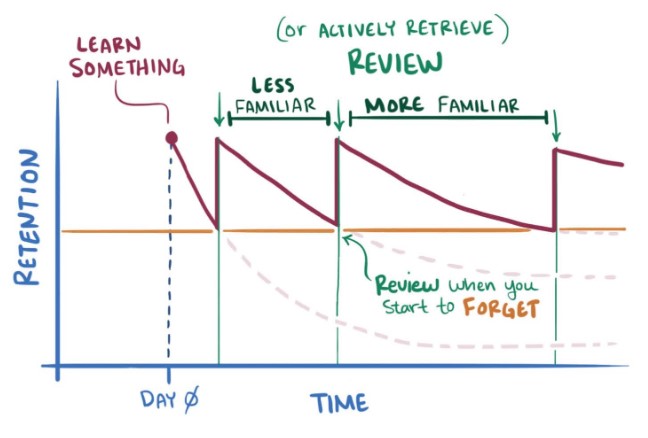Medical Education
Consider using interleaving, spaced repetition and the testing effect in your curriculum.
In the last Medical Education article in Academic Matters, we left you with the word interleaving. Throughout your life as a learner, material and skills practice (i.e., motor behavior) were likely presented to you in a massed or blocked format. Massed or blocked learning presents information or practice one concept at a time before moving on to new information or new skills practice. This is often symbolized as AAAA BBBB CCCC DDDD.
Interleaving, however, provides information or skills practice in a mixed format (e.g., ABCD BADC DCBA CDAB). Learning in this method, when designed appropriately, reinforces repetition of information or skills in a “distributive” or “spaced” format to assist with induction. Numerous studies with different learning material consistently show interleaving as beneficial over blocked in post-testing, particularly when the goal is to discriminate between categories. Areas studied included solving math problems, identifying painting techniques, improving batting or tennis skills, interpreting radiographic patterns and distinguishing psychological disorders. Interestingly, though, when learners are asked if they prefer material to be presented as blocked or interleaved, many often prefer blocked, even though it shows inferior performance in post-testing.
“Interleaving topics or tasks allow learners to form links or connections to previously taught information, thereby facilitating the retention and deeper understanding of new material,” according a 2019 study titled “The Clinical Teacher’s Toolbox” by McSparron, et al. Furthermore, studies suggest that interleaving may be particularly beneficial for adult learners, when longer study is required, and among learners who are experts or have mastered some aspects, as their working memory is stronger and can build on prior knowledge or skills quicker.
The concept of distributive practice or spacing of information has repeatedly been shown to improve memory retention as early as 1885 with Hermann Ebbinghuas’ studies on “the forgetting curve.” The ability to revisit information in spaced intervals — and longer intervals between spacing — assists with long-term memory retention and can prevent decay of critical information, commonly known as forgetting.
The goal is not to relearn or re-present an entire lecture or skill, but to trigger salient points or skills practice for reinforcement. The testing effect is also a useful tool as part of spaced learning, whether learners test themselves or clinical educators provide the testing. Carefully crafted periodic testing should reinforce key learning points.
THE TESTING EFFECT
Moreover, tests can be presented in blocked or interleaved form; interleaved-spaced tests are optimal. As a formative assessment, spaced testing allows the learners and instructors to determine areas of weakness or education gaps early in the process. Clinical educators are not limited to testing formats of true/false or multiple-choice quizzing. They can also consider incasing testing in scenarios and simulations, through small-group activities during lecture time or during rounds, or via audience-response systems that encourage discussion. The ability to add feedback to testing further enhances the effectiveness of the testing effect. This is particularly true if the feedback involves more than telling the learner the answer was correct or incorrect.
Most importantly, spaced education has been shown to be effective in addressing clinical knowledge and practice skills. Specific studies have:
- Found that fellows in an infectious disease fellowship program sustained a positive learner experience and demonstrated mastery of material through spaced testing
- Found that spaced education successfully transferred diagnostic skills in histopathology and improved long-term memory among urology residents
- Shown improvements among pediatric residents’ knowledge regarding pediatric trauma
- Shown improvements among pediatric residents’ clinical knowledge after their pediatric emergency medicine rotation
In another study keying in on skill acquisition and retention, researchers analyzed the effects of spaced versus massed practice of laparoscopic motor skills training. Those in the spaced group outperformed the massed group at the two-week and one-year points. The difference was most evident in the more-difficult laparoscopic training tasks.
The “optimal lag time” between intervals is not definitive, but studies suggest repetition should be soon after initial learning and expanded over time. While there is no silver bullet teaching technique that fits every situation and every learner, interleaving and spaced education techniques offer promising results and are tools medical educators can use to enhance trainee’s performance in their medical training.
Sources: Ebbinghaus, (1885); Pashler, et al (2007); Kornell and Bjork (2008); Kornell, et al (2010); Taylor and Rohrer (2010); Kang and Pashler (2012); Birnbaum, et al (2012); Zulkiply, et al (2012); Rozenshtein, et al (2016); McSparron, et al (2019)



